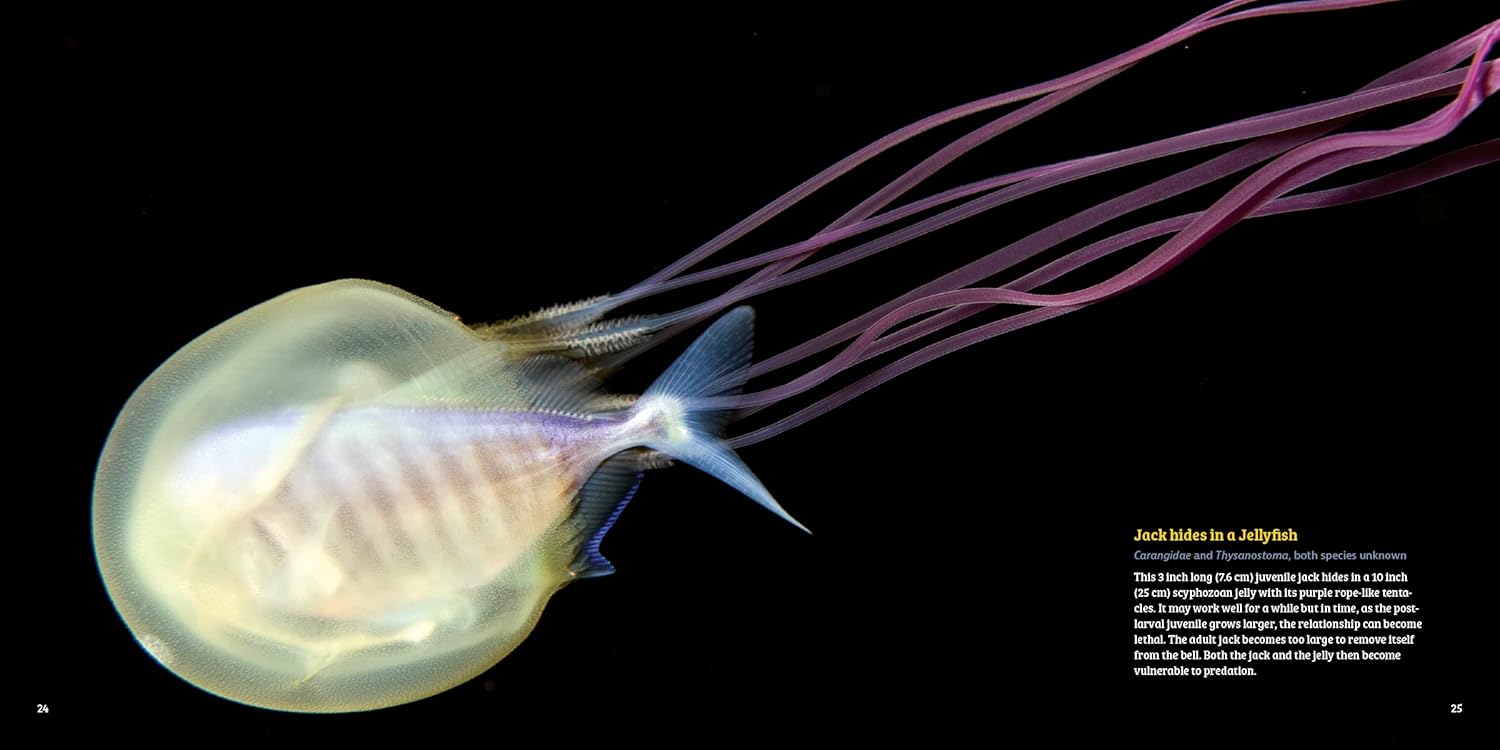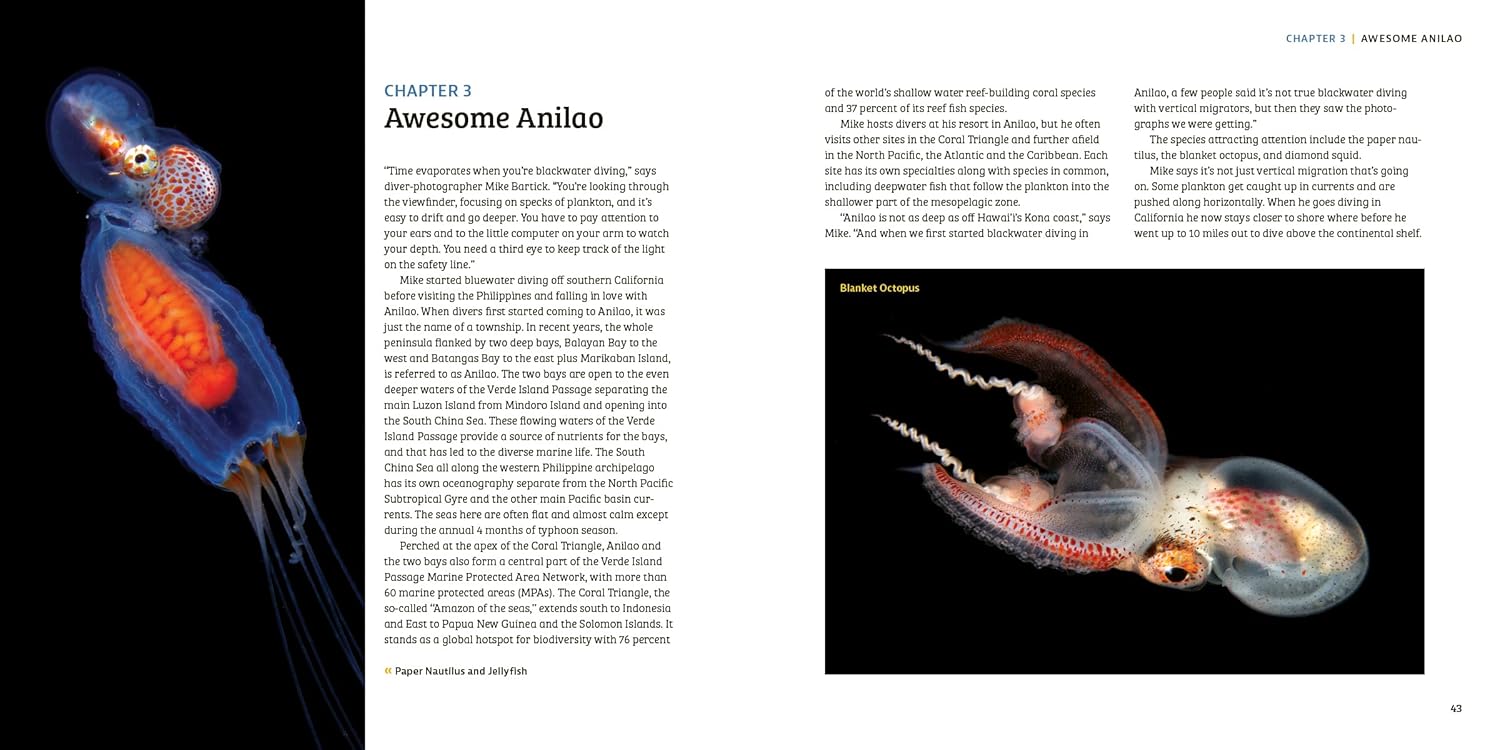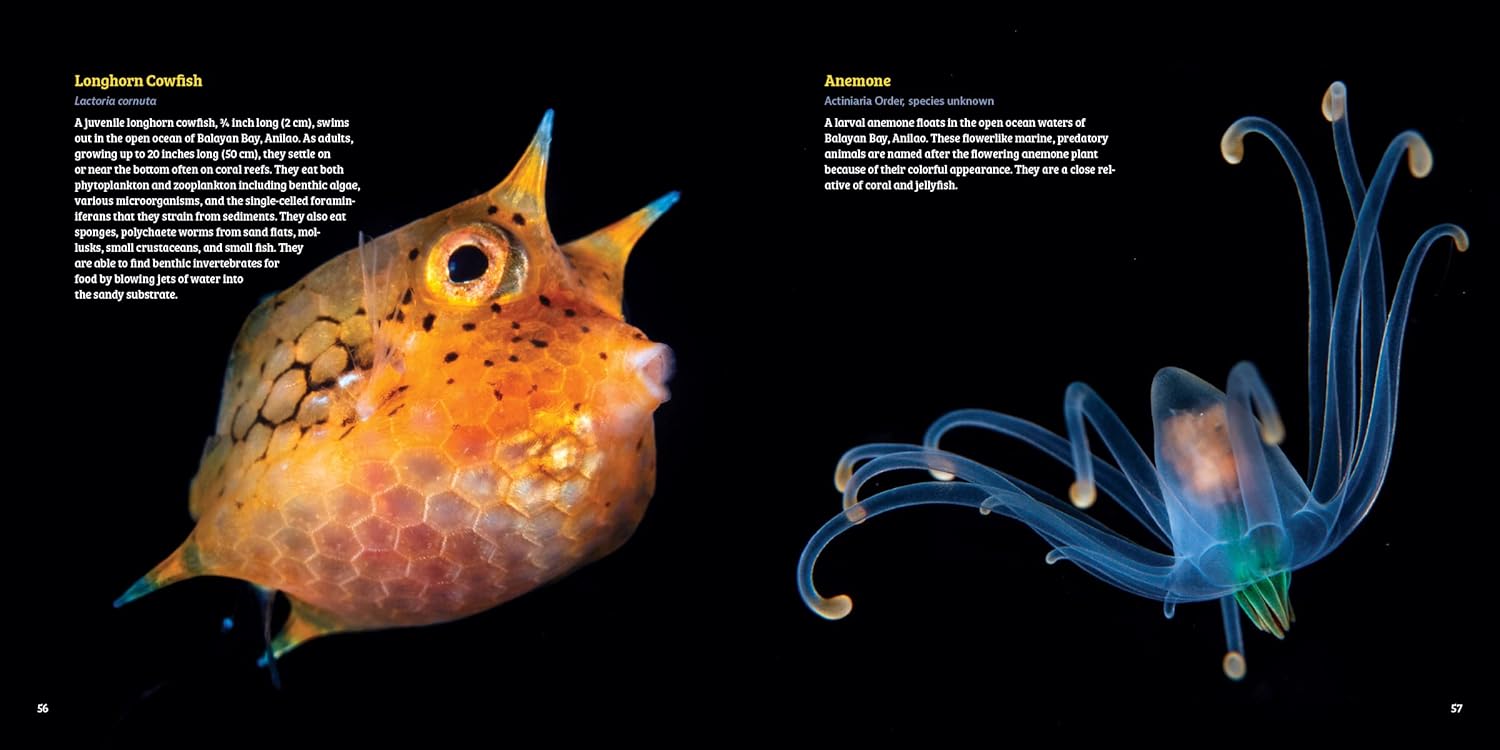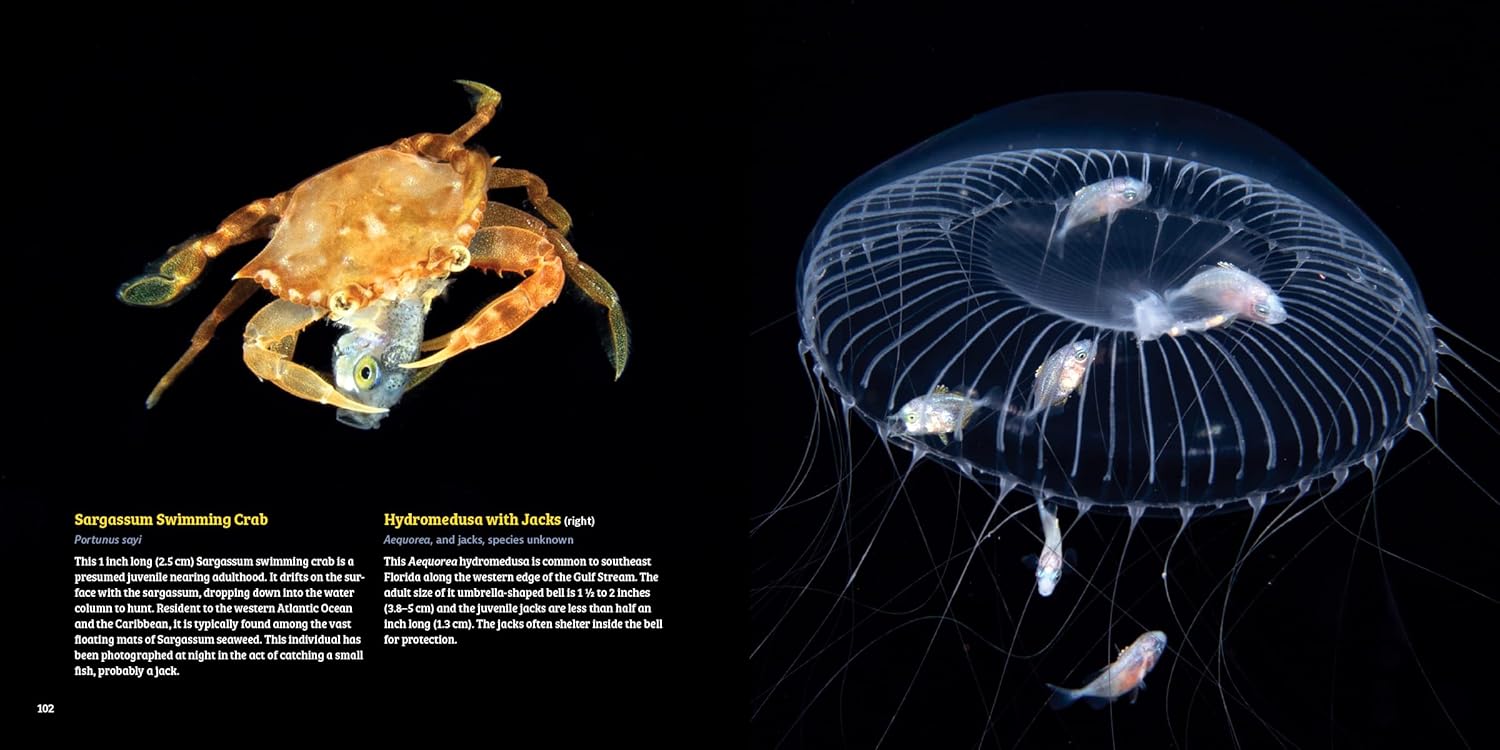Description
Planktonia: The Nightly Migration of the Ocean’s Smallest Creatures takes readers on a mesmerizing journey into the mysterious world of plankton. This captivating book explores the nightly migration of these tiny organisms, revealing their vital role in the ocean’s ecosystem. Through stunning illustrations and engaging storytelling, readers will gain a new appreciation for the beauty and importance of plankton.
Price: $27.95 - $33.52
(as of Mar 05, 2025 12:20:26 UTC – Details)
Planktonia: The Nightly Migration of the Ocean’s Smallest Creatures is an absolutely captivating documentary that sheds light on the mysterious world of plankton. From the eerie glow of bioluminescent organisms to the graceful movements of tiny copepods, this film showcases the sheer wonder of these often-overlooked creatures.
Exploring the Depths of the Ocean
Dive deep into the ocean with Planktonia as it takes you on a mesmerizing journey through the nightly migration of some of the ocean’s smallest inhabitants. Witness firsthand the sheer abundance and diversity of plankton as they embark on their nightly journey to the surface.
The film’s stunning underwater footage provides a rare glimpse into the intricate ecosystems that support these tiny but vital creatures. From microscopic phytoplankton to larger zooplankton, viewers are treated to a visual feast of color and movement that is sure to leave you in awe.
Educational and Entertaining
Planktonia is not just a feast for the eyes – it is also a treasure trove of educational information. The film is narrated by world-renowned marine biologist Dr. Samantha Waters, who provides fascinating insights into the biology and behavior of plankton.
Through her expert commentary, viewers learn about the crucial role that plankton plays in sustaining marine life, from providing food for larger animals to producing the oxygen we breathe. Dr. Waters’ passion for her subject shines through in every word, making the film both informative and engaging.
A Visual Delight
One of the standout features of Planktonia is its breathtaking cinematography. The film is shot in stunning high definition, capturing the vibrant colors and intricate details of plankton in all their glory.
From the delicate tendrils of jellyfish to the intricate patterns of diatoms, the camera work is truly a work of art. Every frame is a visual feast, drawing viewers into the mesmerizing world of plankton and reminding us of the beauty and complexity of life beneath the waves.
A Call to Action
Beyond its aesthetic appeal, Planktonia also serves as a powerful call to action. The film highlights the threats facing plankton populations, from pollution to climate change, and emphasizes the urgent need for conservation efforts to protect these vital organisms.
By shining a spotlight on the beauty and importance of plankton, Planktonia inspires viewers to take action and become stewards of our oceans. Whether through supporting marine conservation initiatives or making simple changes in our daily lives, we can all play a role in preserving the delicate balance of marine ecosystems.
In conclusion, Planktonia: The Nightly Migration of the Ocean’s Smallest Creatures is a must-see documentary that will leave you spellbound. With its stunning visuals, informative narration, and powerful message, this film is a true masterpiece that deserves a place in every nature lover’s collection. Watch Planktonia and be prepared to be amazed by the wonders of the ocean’s smallest inhabitants.
Price: $27.95 - $33.52
(as of Mar 05, 2025 12:20:26 UTC – Details)
Product Description
When people hear the word “migration,” they think of animals that move from a feeding area to a breeding area and back each year. But the greatest migration on Earth happens twice every night. The movement is largely vertical and performed by plankton followed by predatory fish, squid, octopus and other species that have acquired a taste for plankton. The migration starts deep in the waters of the ocean at sunset. As they move, the plankton nibble on plant plankton and other tasty morsels in the water and, eventually, some on each other. The feeding ends just before dawn when the plankton retreat to the depths of the ocean to hide during the day until the next evening, when they migrate back up the water column.
In Planktonia, Erich Hoyt invites readers to dive into the dazzling nighttime ocean. Countless microscopic plankton — larval creatures such as ornate ghost pipefish, left-handed hermit crabs and bony-eared assfish — ascend to the upper waters to feed, returning to the depths before sunrise. These tiny planktonic creatures are delicate and beautiful; some look terrifying; and most look nothing like the creatures they will become as adults. This great vertical migration attracts larger adult creatures, too, from the solitary 6-inch (15 cm) bigfin reef squid and the fierce and hungry 6 1/2 foot (2 m) female blanket octopus, which is up to 40,000 times heavier than her male mate. Everyone comes here for the midnight feast, and they are all ravenously hungry.
Chapters in this book include:
Hawai’i: From Bluewater to Blackwater Awesome Anilao The Gulf Stream Procession of Life Blackwater White Sea Precious Life of Plankton Blackwater Unlimited From Blackwater Passion to Protection.
All life in the ocean depends on plankton. Plankton plays a key role in sequestering carbon against climate change. The great nightly vertical migration highlights the importance of protecting not only ocean species but also ecosystems that embrace ocean processes from the depths of the sea to surface waters.
From the Publisher


Planktonia by Erich Hoyt invites readers into the world of microscopic plankton with over 100 close-up photographs. This book was recently added to the the 2024 AAAS/Subaru SB&F Prize for Excellence in Science Books longlist for the Young Adult Science Book category.
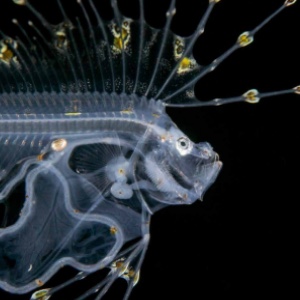

Cusk Eel (Brotulotaenia nielseni)
This 2 inch long (5 cm) larval fish has elaborate dorsal- and anal-fin rays. Some researchers have described them as looking like a seabird feather, but in the water, the larval form more closely resembles Forskalia siphonophores. This mimicry might deter predators that avoid stinging siphonophores.
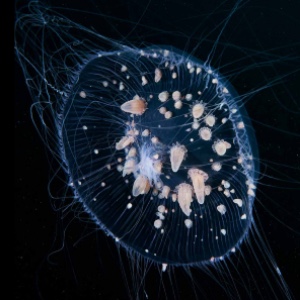

Jellyfifish with riding Sea Anemones (Genera Aequorea and Peachia, species unknown)
These larval sea anemones, from the Okhotsk Sea of Russia, also called actinia, range in size from 1/40th to 1⁄4 inch (.05 cm to 0.5 cm). When the larvae jump aboard Aequorea jellyfish, they have both a source of food and good protection wherever the jellyfish goes. As adults, the sea anemones detach from the jellyfish and settle on the bottom where they burrow into the sediment and turn into common burrowing creatures.
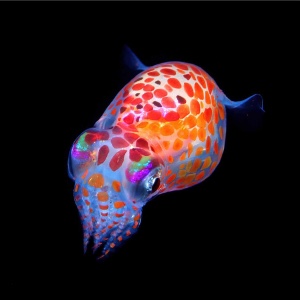

Bobtail Squid (Species unknown)
This juvenile bobtail squid, only 5⁄8 inches long (1.5 cm), may bury itself, typically in the sand, using camouflage to hide from predators. But as night approaches, the squid finds that the bioluminescent bacteria Vibrio fischeri, feeding on amino acid and sugar in the light organ of its body, have begun to glow. The color, pattern and intensity of the light may be shaped through pigment-containing groups of cells called chromatophores. The light may attract some prey and distract predators. The squid has a symbiotic relationship with the bioluminescent bacteria, which can benefit both species.
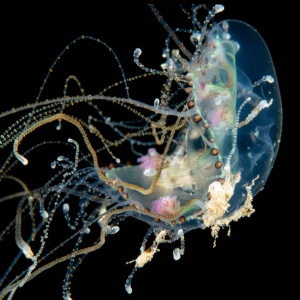

Hydromedusa (Olindias malayensis)
This tiny adult stage medusa, with a bell only 1⁄2 to 3⁄4 inches (1.3–2 cm), drifts through the waters of Lembeh, Indonesia. Following the free-swimming planula stage, it will turn into a polyp before becoming an adult medusa with a dome-shaped bell, tentacles with adhesive suckers and stinging cnidocytes. Attached to the base of the tentacles is a pair of sensory receptors called statocysts, as well as many short tentacles with rings of cnidocytes for immobilizing prey.


Salp with male Argonaut and Hyperiids (Family Salpidae, Genus Argonauta and Order Amphipoda, species unknown)
A window on the blackwater Mediterranean offff Italy: A male argo- naut, or paper nautilus, about 5/16 inch long (0.8 cm), perches on part of a salp colony, surrounded by hyperiids, tiny big-eyed marine amphipods. Some paper nautili will actually burrow inside a salp, perhaps to avoid predation while having access to a ready food supply.
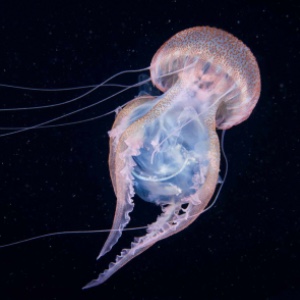

Mauve Stinger capturing a Salp (Pelagia noctiluca and Subphylum Tunicata, species unknown)
A common jellyfish in the Mediterranean Sea, the mauve stinger has stinging cells not only on the arms but on the dome as well. Here, a 4 3⁄4 to 8 inch (12–20 cm) individual has captured a salp and is feeding on it. Hunting both day and night, mauve stingers form huge jellyfish blooms in some areas. The mauve stinger can glow bright blue when it’s disturbed.
Publisher : Firefly Books (August 15, 2022)
Language : English
Hardcover : 176 pages
ISBN-10 : 0228103835
ISBN-13 : 978-0228103837
Item Weight : 2.31 pounds
Dimensions : 10 x 0.64 x 10 inches
Price: $27.95 - $33.52
(as of Mar 05, 2025 12:20:26 UTC – Details)

 Add to favorites
Add to favorites 



